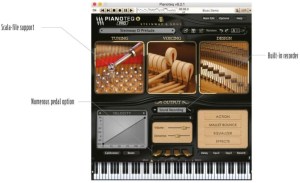

If you enable the curve to curve in VPC1 + Pianoteq they will operate simultaneously. You can switch between them by pressing the power button and one of the top five black keys.

VPC1 in its memory stores settings of five curves, and they can be used without turning on VPCEditor. Do you press (input), and they change in accordance with a predetermined curve. The sensitivity of the keyboard, or the speed of initially processed VPCEditor, and then in Pianoteq. I have managed to get the VPC1 to sound much better this way.ĭo note that there has had to be quite a drastic change to the default Pianoteq curve (in Pianoteq velocity curve pane) but early results prove positive. Since realising that that velocity response is much tighter using the 'solid orange' curve, I have been working on the Pianoteq velocity curve to achieve a pleasing piano curve. I forget offhand which VST instrument this curve was custom designed for, but it isn't Pianoteq! Pianoteq's custom curve lights the power button solid green. I have found that the most even velocity response is obtained by using the curve which lights the power button solid orange on the VPC1. I am currently using a Casio Privia power pack / AC/DC adapter that works perfectly and is better quality.Īnyhow, the reason for my post is this. I have recently managed to get my VPC1 working again after the supplied power pack / AC/DC adapter blew. The photo curves relative to the horizontal zero change) I would ask Modartt - Kawai clarify the rate curve for default VPC1 (for VPCEditor). Perhaps since models were established some improvements that can be disclosed to a greater extent by using more correct velocity curve. Judging by the news, the curve for VPC1 created in collaboration with Modartt was created during version ~4.5. It inspires to exercise skills, not to search for the best settings. But, nevertheless, this curve is the most attractive for me so far. in some places closer to the version the default curve Pianoteq, in some - option for MP11. Perhaps the true curve for combinations Pianoteq-VPC1 is somewhere. In opposition, the default curve for Pianoteq I find a little cotton, slowing down. From negative - perhaps too easy, bright, complex in pianissimo. The positive features of this curve: a good predictability, contrast, large depth to pianissimo, a sense of "key weight", matching sensations and the resulting sound. I corrected region fortissimo to a value of 127. But it was limited in fortissimo (no more than 114). Among the default curves appeared to curve MP11. In other words, if you alter the keyboard's curve, set PianoTEQ's llinear, and vice versa.Īnalogus, yes, I liked the curve, too. Note: Whichever curve you wish to adjust (keyboard's or PianoTEQ's), make sure the other curve is set linear/normal. into the PianoTEQ velocity graph, or simply add a control point at 75 37
#Pianoteq 5 kickass software#
It can be used at keyboard or software stage and the simplest is just to paste. And it is is so, so very simple that it only requires a single control point!!!

After quite a number of attempts, I realised there was a simple basic shape that appeared to remain comstant with each try. Having had and enjoyed this 88 note wonder for a few months now, and having become more than a little inquisitive regarding the custom PianoTEQ curve, I decided to have a more serious look at the VPC1 Editing Software's Custom Velocity Curve Generator. I anticipate a tirade of sorts, but am willing to run the gauntlet!!!


 0 kommentar(er)
0 kommentar(er)
